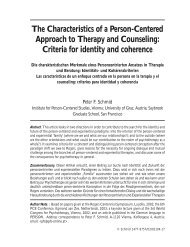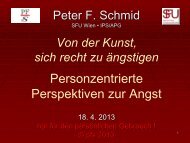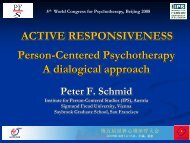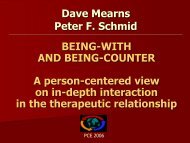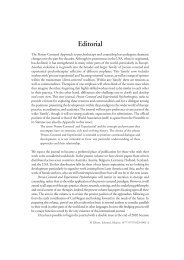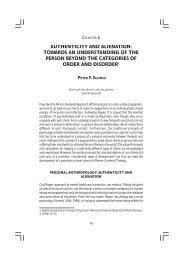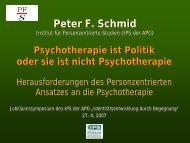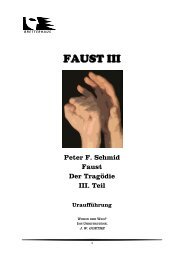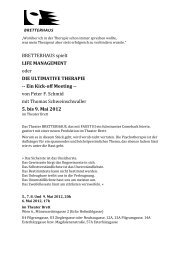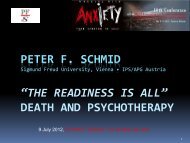linked - Peter F. Schmid
linked - Peter F. Schmid
linked - Peter F. Schmid
- No tags were found...
Create successful ePaper yourself
Turn your PDF publications into a flip-book with our unique Google optimized e-Paper software.
DARE COUNTY REGIONAL AIRPORTAirport Master Plan UpdateSECTION 2 – AIRPORT INVENTORY2.0 INTRODUCTIONThe inventory is a systematic data collection thatprovides an understanding of past and presentaviation factors and community trends. Acomprehensive inventory forms the basis forairport recommendations throughout the DareCounty Regional Airport Master Plan Update(AMP).An on-site inspection was conducted by theconsultant in January 2005 to note the physicalcondition of key airport facilities, equipment and services, confirm on-and off-airportland uses, interview key County/Airport constituents, and review Airport activitylogs and records.2.1 MQI AIRPORT LOCATIONExhibit 2-1 depicts the Airport’s location and vicinity. Dare County is located innortheastern North Carolina, on the outer banks of the Atlantic coastline.EXHIBIT 2-1AIRPORT VICINITY & LOCATION MAPJ:\2301 (Dare)\0402 AMP Update\Report\2301-0402 AMP Section 2 - Inventory (Final).docPage 2-1• SECTION 2INVENTORY
FACILITATIVE RESPONSIVENESSTHE CONCEPT OF NON-DIRECTIVITY AS DISCUSSED IN THEPERSON-CENTRED APPROACHQuite early in the history of the person-centred approach, the concept of non-directivitymarked a crucial point in the understanding of its principles; it might even be seen as theexpression of the paradigmatic shift from problem-, solution- and therapist-centred toclient- and person-centred therapy. Even some 60 years later, it only recently became thepassword for those who claim to adhere to truly ‘Rogerian’ therapy In recent yearstheoreticians and practitioners who understand themselves as ‘non directive client-centredtherapists’—thus making ‘non-directivity’ the shibboleth of being genuine to Rogers’intentions—claim that there is a fundamental distinction between those who followRogers’ original approach and other orientations, developed out of (and away from)Rogers’ concepts. Barbara T. Brodley (2002, 2003), for example, enumerates Bozarth,Brodley, Brody, Patterson, Raskin, Shlien, Witty, Zimring and others as being withinthe first category; and lists focusing-oriented therapy (Gendlin, 1996; Hendricks, 2002),experiential therapy (Lietaer, 1998) and process-experiential therapy (Elliott and Greenberg,2002) among the other approaches. As a matter of fact, in these experiential traditions, theconcept of non-directivity was widely given up and replaced by an experiencing-orientedand process-focused stance, together with a distinction between contents and process. Thedebate about the nature and importance of non-directivity, often fought in internet postings(e.g. the CCT/PCA e-mail network, http: //texaslists.net/cctpca), came up anew and verystrongly after controversies at the Person-Centered and Experiential World Conference2003 in Egmond aan Zee in The Netherlands (PCEP, 2004).Trying to understand carefully the original meaning of the concept as elaboratedby Carl Rogers, it can be found that non-directiveness is an expression of a basicanthropological and epistemological stance; that is, a philosophical conviction, not amatter of method or technique (if method and technique are understood in their usualcontemporary meaning, and not in their original sense, in which they mean ‘way’ and‘art and science’ respectively).In order to understand how the focus shifted in the comprehension of ‘being nondirective’,from the early days to contemporary discussion, we need to take a look intothe history of the concept.CARL ROGERS: ‘THE PERSON WHO SHOULD GUIDE IS THE CLIENT.’In the beginning, Rogers’ emphasis on non-directivity was a counter-position to thetraditional medical model and the more directive forms of psychotherapy that were invogue at that time: classical psychiatry, psychoanalysis and behaviour therapy (see <strong>Schmid</strong>1996: 268–70, 1999, 2002b). In order to separate his way of approaching a client frommanipulative or guiding therapeutic behaviour he called it ‘non-directive,’ as opposedto the traditional ‘directive’ approach (Rogers, 1942; Raskin, 1947). Although in thebeginning the emphasis was on the way of proceeding and on the counsellor skills (i.e.,which intervention brings about which change?), the underlying intention was clear:2
PETER F. SCHMIDcreating a non-judgemental atmosphere, a relationship free from anxiety, and fosteringverbalisation of the client’s emotions and experiencing, as well as their self-exploration.Thus, from the very beginning of his ‘newer therapy’, at a time when the main task forthe therapist was to be an alter ego for the client, Rogers opposed control over the client,or therapist-centred attitudes and behaviours, and wanted to stress the responsibility ofthe client. Most important of all, he wanted to emphasize trust in the client and his orher capabilities. He stated clearly: ‘Nondirective counseling is based on the assumptionthat the client has the right to select his own life goals, even though these may be atvariance with the goals his counselor might choose for him’ (Rogers, 1942: 126–7).As early as 1942, Rogers wrote that the difference between a ‘directive versus nondirectiveapproach’ (pp. 108–28), is a difference in philosophy of counselling and values.Therefore, the question for him was whether there is a right of the experienced and morecapable to guide the inexperienced and less capable or, conversely, a right to independencefor every person. This difference between problem-centred and client-centred is, accordingto Rogers, an issue of social and political philosophy (see <strong>Schmid</strong>, 2004a: 37–8).Non-directivity was the term for the shift of the focus of attention of both, therapistand client, from therapist interpretation and guidance, to client awareness of andattentiveness to his or her inner world of experiencing. The term ‘client-centred’ (Rogers,1951) expressed in a positive way, what the term ‘non-directive’ conveyed in anexclusionary one. From the very beginning, non-directiveness must be seen in the contextof the philosophy of experience-centredness, and of the therapist’s unconditional positiveregard for and empathic listening to the client (see Barrett-Lennard 1998: 59–60; <strong>Schmid</strong>,1996: 268–70, 1999).Further developments in Rogers’ experience, understanding and theory of therapy,stressing the encounter quality of the person-to-person relationship of psychotherapy(Rogers, 1962), did not abolish the concept of non-directivity. Seen from the relational,inter-subjective perspective non-directivity still was seen as a core aspect of the expressionof trust in the client’s self-healing capacities—that is, their actualizing tendency. But it gotan additional importance as an expression of the ‘way of being with’ the client (see below).Rogers (1975: 26), interviewed by Evans, responded to the question of whether hewould say that he had qualified somewhat the notion of being non-directive during thelater periods of his work:No. I think perhaps I enriched it, but not really qualified it. I still feel that theperson who should guide the client’s life is the client. My whole philosophyand whole approach is to try to strengthen him in that way of being, that he’sin charge of his own life and nothing I say is intended to take that capacity orthat opportunity away from him.RECENT AND CURRENT DEBATE: NON-DIRECTIVITY AS REALIZATION OF THE CORECONDITIONS …In the last two decades the controversial issue of non-directivity has usually been discussedin combination with the understanding of the core conditions and their sufficiency;3
FACILITATIVE RESPONSIVENESSthat is, in terms of attitudes (see <strong>Schmid</strong>, 1996: 268–70; 2001b: 66–8).Keith Tudor and Tony Merry (Tudor and Merry, 2002: 89; Tudor et al., 2004),among others, state that non-directivity is a matter of attitude not of behaviour. Merry(1999: 75) points to the non-authoritarian nature of person-centred therapy: ‘Thecounsellor does not choose the ‘agenda’ for the client or attempt to control or determinethe processes that occur within the client.’Jerold Bozarth (1998: 51, 86, 2002) regards non-directivity as a practice applicationof the therapist’s unconditional positive regard, and as an essential component of Rogerianempathy. For him the non-directive attitude generally is a logical deduction from thecentral theoretical hypothesis. ‘There is, in essence, no room for directivity in Rogers’conceptions of therapy and the therapist’s role’ (1998: 56).Barbara Temaner Brodley (1999a: 79) asserts that ‘the concept of non-directivitycomes into existence within the meaning of these therapeutic attitudes’, namely the coreconditions. According to Brodley (1997, 1999b, 2003; Merry and Brodley, 2002) thenon-directive attitude is inherent in the term ‘client-centred’ and inherent in thetherapeutic attitudes. She argues that it is a part of their essential meaning, because itguarantees the protection of the client’s autonomy. Thus, living the basic attitudes isinherently non-directive and respectful of the client’s self-determination. She maintainsthat the attitudes are expressed by empathic following responses, a willingness to answerquestions and accommodate requests from clients and unsystematic responses from thetherapist’s frame of reference—behaviours that do not violate the client’s fundamentalright to self-determination. Brodley (1990, 1999a) further emphasises that ‘client-centred’and ‘experiential’ are two different therapies that turn on the issue of directivity andinfluence. Garry Prouty (1999) argues similarly.Lisbeth Sommerbeck (2004) views the non-directive attitude of the client-centredtherapist as a logical consequence of the uniqueness of each individual client and theunconditional positive regard towards him and of the assumption that the humanorganism’s continuous interaction with its environment is a non-linear dynamic system.Therefore, the client-centred therapist not only should not be an expert, but cannot be anexpert on what is best for the client.Expertism is also an issue for Cecil H. Patterson (2000: 181–4). He claims that thematter of being non-directive is to free a process of self-discovery and self-actualization,to foster autonomy, responsibility and self-determination. Patterson argues against theidea it could make sense that within a ‘principled non-directivity’ (see below) the therapistmay offer activities, exercises, techniques, directions, advice, interpretations, etc. in orderto please the client and his or her wishes. He underlines that it is naïve to believe thatclients are really completely free to reject such offerings from one who is perceived, tosome extent at least, as an expert. ‘Moreover, these offerings are inconsistent with respectand with the end of client-centered therapy—a responsible, independent, self-actualizingclient’ (ibid.: 182). He also remarks that the definition of ‘placebo’ is ‘to please theclient’.Paul Wilkins’ (2003: 85–98) asserts that it is the therapist’s intention that matters.He reinforces that Rogers’ point was to contrast his approach to approaches with a4
PETER F. SCHMID‘knowing better’ stance of therapists, to place emphasis on the client’s right to select thegoals in therapy. So he sees non-directivity as a relative concept, contrasting with theidea that therapists, not clients, are the experts. Though non-directive therapists doinfluence their clients (by their own experiences, cultural biases, their way of behavingand talking, their office, dressing, etc.), their basic intention communicates the messagethat the client is capable of deciding on his or her own about the process and contents oftherapy. In opposition to the criticism that therapists should not deny but shoulddeliberately use their expertism (i.e., the therapist must not be non-directive), Wilkinsargues that no such stance is needed. He points to the theory that differentpsychopathologies do not require different treatments (opposing what experientialtherapists argue—that it is important to bring about specific processes in order to moreefficiently support change). As Rogers (1957) put it—therapist expertise is only a needof insecure therapists (see <strong>Schmid</strong> 2004a, 2005a, 2005b).Dave Mearns and Brian Thorne (2000: 191) shift the focus of interest in thedebate about non-directivity from the therapist’s behaviour to the client’s experience.They assert: ‘The importance of directivity is not in what the counsellor does but inwhat the client experiences. […] The question which should be asked is not ‘is thetherapist behaving directively?’ but ‘is the client being directed?’ In doing so, they decisivelystress the importance of the relationship for the understanding of the importance ofnon-directiveness.… OR AS AN OUTDATED CONCEPT TO BE REINTERPRETED OR REPLACEDOthers think that certain kinds of directivity are not incompatible or irreconcilable witha person-centred stance: David Cain (1989, 1990) does not regard non-directivity as abasic characteristic of the person-centred approach. He thinks that to impose nondirectivityon the client may hinder or restrict him or her. Of course, an imposition ofnon-directivity would be entirely inconsistent with the intention that comes from holdinga non-directive attitude. In Cain’s eyes the task is to learn with the client how he or sheis learning best; otherwise the therapist would hinder themselves in offering their personaland professional resources and will not be able to adjust to the individuality of eachclient.Barry Grant (1990, 2004) positions himself against Cain who, in his view, seemsto have an ‘in order to’ attitude and an orientation towards effectiveness. Coming froman ethical point of view, Grant considers non-directiveness to be ‘the hallmark of clientcenteredtherapy, the characteristic that distinguishes it from all other therapies’ (2004:158). He also states that ‘Non-directiveness, the absence of intention to cause specificeffects or bring about specific changes in clients, is consistent with respecting the rightto self-determination’ (ibid.). He goes on to make a distinction—on the basis of theimage of the human being and the motive of acting that the therapist holds—betweeninstrumental ‘non-directiveness’ as a means for growth and ‘principled non-directiveness’.According to Grant, the latter is to be understood as a fundamental expression of respect,regarding the other as a mystery. Principled non-directiveness is an absence of the intention5
FACILITATIVE RESPONSIVENESSto make anything in particular happen. It is an expression of an attitude towards theworld of facing it as a miracle, as an object of love, not will.David Coghlan and Edward McIlduff (1990), not unlike gestalt therapists,discriminate between process and contents. They discriminate between giving a structureconcerning the means of processing and being directive concerning the contents.Germain Lietaer (1992; 1998), an influential advocate of the experiential wing inhumanistic therapies, favours the shift from non-directivity to experience-orientation.He distinguishes between directivity and manipulation and believes that directivity ‘inits positive aspects refers to the therapist’s task-oriented responses and interventions’(1998: 63). In his opinion to be non-directive simply means that there is no therapyplan. He emphasizes that directivity has nothing to do with manipulation, control orpressure and warns of a ‘directivity phobia’ (Lietaer 1992b: 11–12, 16, Lietaer andDierick 1996: 15).The advocates of focusing-oriented (Gendlin, 1996), process-experiential or processguiding(Elliott and Greenberg 2002), emotion-focused (Greenberg, 2002) and goalorclarification-oriented therapy (Sachse, 2003, 2004) distinguish between directivityregarding the contents of the client’s communications and directivity regarding thetherapeutic process. Experiential and process-directive writers assert that their directiveintentions are focused on clients’ process, not their content (e.g. Greenberg, Rice andElliott, 1993; Gendlin, 1974). They do not intend to direct clients’ contents in thesense of directing the client to talk about certain topics. But they see it as the therapist’stask to steer the client’s process according to their knowledge about the importance andnature of it. In return, Brodley (2003) and others criticise that they overlook the factthat any process-directive procedure changes the content of their client’s thoughts, feelingsand communications and that process-directive therapists ignore that their directiveprocedures require the client to surrender to the therapist’s expertise.Finally, there are authors who simply view ‘nondirectiveness’ as a ‘myth’ (Bowen,1996) and try to use transcripts of Rogers’ therapy or demonstration sessions to provetheir assertion. In doing so they provide a classic example of understanding and discussingthe concept of non-directivity on the level of intervention techniques.SOME MISUNDERSTANDINGS: WHAT NON-DIRECTIVITY IS NOTFollowing from this short survey, some classic misunderstandings of the concept ofnon-directivity can be cleared up easily (see <strong>Schmid</strong> 1996: 268–270).Non-directivity is not inactiveNon-directivity has nothing do with passivity or inactivity, nor is it something likeabstinence. It has nothing to do with non-involvement. Also, the caricature of a wishywashybehaviour (‘non-direct’), never taking a stand, squirming with embarrassment,always hesitating to ask questions (see Pörtner 1994: 74), has nothing at all to do withperson-centredness. The same goes for simple restatements or a wooden technique ofreflecting of feelings (Rogers, 1986a). The peak of misinterpretation was definitely reached6
PETER F. SCHMIDwhen non-directivity was contorted into the technique of simply mirroring the client’swords. Non-directivity is in actuality an active and pro-active way of interaction in theencounter process of therapist and client, as will be shown below.Non-directivity is not (necessarily) unstructuredStructure refers to a specific order. A group or a dialogue can be structured or unstructuredin terms of the various issues of setting in therapy; including its time frame, the order ofspeakers in a group and other elements of structure. Brainstorming, to examine anotherexample, is structured if there is the rule that all ideas are collected without comment orassessment. Directivity refers to the intention as to why such an order is set or denied. Ithas to do with the way somebody tries to reach his goals (see <strong>Schmid</strong>, 1996: 175–6;Coghlan and McIlduff, 1990). This leads to the question of influence.Non-directivity is not non-influentialThe notion of ‘directive versus non-directive’ has nothing to do with whether therapy isan influencing process. Of course, there is therapist intent to influence the client.Otherwise, why would therapists do therapy with clients? In relationships there is noway not to influence; one cannot not influence. The relevant issue is the nature of theinfluence (see also Patterson, 2000: 182). It is the nature of therapist influence thatshould be questioned when the issue of ‘directive versus non-directive’ is examined. Inbeing empathic, the person-centred therapist and facilitator avoids directivity in termsof selecting the topics, interpreting the meaning of the client’s feelings and cognitionsand steering the process of therapy. Non-directive empathic understanding is aninfluencing attitude and behaviour. It most likely influences clients to treat themselvesand their processes in a similar way. Active listening of this type influences.The misunderstanding of non-directivity as non-influencing highlights an oftenneglected difference: what a therapist does (or fails to do) always has an effect or impact,but this must not be confused with an intention to have a certain effect. Therapists arealways paying more attention to certain things and less to others—intention makes thedifference as to what impact or influence this has on the client. Concerning his work ingroups, Rogers stated (1971: 276), ‘(T)here is no doubt that I am selective in my listeningand hence “directive”, if people wish to accuse me of this.’ He stresses that he isunquestionably much more interested in the meaning the experiences have for a clientin the moment and the feelings which they arouse in the client, than the stories they tell.‘It is these meanings and the feelings to which I try to respond’ (ibid.). Thus, even activelistening may be seen as directive in terms of influencing. But the crucial point is how itis done, and whether one aims at a specific goal.Non-directivity is not a denial of powerAs there is influence, there is power. The claim for non-directivity is not a denial ofpower, as is often insinuated. On the contrary, the non-directive therapist is very awareof his power and therefore uses it particularly carefully; that is, in a way that bringsabout empowerment of clients by trust in their resources. In other words: the goal of7
FACILITATIVE RESPONSIVENESSperson-centred influence is to foster the process of actualization. The ‘means’ to do so isby being present—a way of being and behaving that is explicated in the description ofthe core conditions (see below). Everything else, including any kind of directivity, isincompatible with these ‘means’ (see Patterson, 2000).Non-directivity is not a techniqueIt is definitely inadequate to deal with all of these questions in a discussion on the levelof techniques. Non-directivity is nothing that is used ‘in order to’; it is not an instrument.It is true that non-directive therapists do not direct, control, guide, steer, put somethinginto somebody’s mind or manipulate. It is true that they do not give advice, interpret,diagnose, question, interrogate, instruct, rate, evaluate, judge. And it is also true thatthese ‘don’ts’ are consequences of a fundamental non-directive attitude.But there is much more. It is important to emphasize that discussing non-directivityon the level of behaviour is wrong. It is necessary to view non-directivity in the contextof the attitude(s). But even this does not necessarily hit at its core (as the ongoingdiscussion proves). Non-directivity is a matter of the underlying image of the humanbeing, a matter of the theory of knowledge that is held and a matter of the respectiveethical stance.Non-directivity is thus a matter of basic beliefs. People who think that directivity isnecessary in therapy and counselling have a different image of the human being, adifferent concept of how to deal with knowledge and a different ethical stance fromthose who work with their clients on the basis of non-directiveness. Since it is of no useto argue over beliefs (they precede acting, thinking and science), there is no way to saywho, ultimately, is right. There is no way to convince each other (<strong>Schmid</strong>, 1999: 178–9). Different convictions lead to different consequences. The only thing one really canrecord is that there is a difference; and to have an honest look at the consequences.THE NATURE OF THE THERAPEUTIC RELATIONSHIPACCORDING TO A PERSON-CENTRED IMAGE OFTHE HUMAN BEINGPERSON-CENTRED ANTHROPOLOGY: THERAPY AS PERSONALISATION AND AS ENCOUNTERPERSON TO PERSONThe name of the person-centred approach was not chosen by coincidence. Whateverelse the reasons were to coin the term ‘person-centred,’ it was also meant from the verybeginning to express a certain anthropological stance, based on a specific image of thehuman being, developed in the occidental philosophical tradition. Rogers’ thinking wasdeeply rooted in this tradition. As the name suggests, the underlying key concept of personcentredtherapy is the understanding of the human being as a person, and the understandingof the therapeutic relationship as an encounter (or meeting) person to person.What it means to be a person, and the consequences that follow for a person-8
PETER F. SCHMIDcentred approach to psychotherapy, has been described previously in detail (<strong>Schmid</strong>,1991, 1994, 1998a, 1998c, 2002c: 58–65, 2004b, 2005c). What follows is only a briefsummary.The person-centred image of the human being is based on the view of men andwomen as persons. According to two different yet dialectically <strong>linked</strong> traditional strandsof meaning in the history of theology, philosophy and psychology, the human being ischaracterized as a person if he or she is denoted in his or her unique individuality, worthand dignity, as well as in his or her interconnectedness. Both the substantial notion ofbeing a person (i.e., being from oneself) and the relational conception of becoming aperson (i.e., being from and towards others), belong to the meaning of this personcentredimage of the human being. They are dialectically and inseparably connected. Tobe a person describes autonomy and interconnectedness, individuality and solidarity,sovereignty and commitment. Carl Rogers combined both views in a unique way forpsychotherapy when he built his theory and practice upon the actualizing tendency asthe motivational force constructively working on behalf of the client (substantialdimension), which is maximized in a facilitative relationship of a certain kind (relationaldimension). This facilitative relationship is an encounter provided by a person who isreally present; that is, living the core conditions described by Rogers (1957) as fully aspossible in this relationship (see below).Person-centred personality and relationship theory understands personalisation asa process of becoming independent and of developing authentic relationships. Therefore,the respective theory of therapy understands therapy as both personality developmentand encounter person to person. At the same time it is important to be aware that bothclient and therapist are understood as persons. Both therapist and client develop togetherin this relationship. Thus, both notions of being a person are also important for thetherapist: unconditional acknowledgment and empathic positive regard as a way ofbeing ‘with’ the client, together with a position ‘counter’ to the client; that is, a committed‘en-counter’.According to dialogic (or encounter) philosophy the relationship to somebody as aperson is called an encounter. To encounter means to meet the unexpected. Betweenpersons, it means to meet face to face. One of the consequences of viewing the humanbeing as a person is the realization that accepting another person means trulyacknowledging him or her as an Other in the sense of dialogical thinking. He or she is noalter ego, no close friend a priori, no identifiable person. He or she is an entirely differentperson. Etymologically, the word ‘encounter’ comes from the Latin ‘contra’, which means‘against’, To en-counter another person, first of all, means recognizing that the Otherreally ‘stands counter’, because he or she is essentially different from me. Thereforeencounter is an amazing meeting with the reality of the Other. It means that one istouched by the essence of the opposite (Guardini, 1955). In order for this to happen,there must be a non-purpose-oriented openness and a distance which leads to amazement.‘Being counter’, according to Martin Buber (1923), is the foundation for meeting faceto face, an event in which one becomes present to the Other.This ‘position’ appreciates the Other as somebody independent, as an autonomous9
FACILITATIVE RESPONSIVENESSindividual, different and separated from me, worthy of being dealt with. In being counterthe otherness of the Other is appreciated. To stand counter also means to give room toeach other and to express respect. In facing the Other I can see him or her and acknowledgethe Other’s uniqueness and qualities. (More on encounter as a basic category for theperson-centred approach: <strong>Schmid</strong>, 1991, 1994, 1998b, 2002a, 2002c, 2002f.)Moreover, if a person is constituted through their relationship to another person,to be a person means to be a response. The movement always originates from the Thou:it is the call, the addressing of another human being, which evokes a response—a responsefrom which I cannot escape, because nobody can respond in my place. We are obligedand responsible to the Other and owe him or her an answer—making the ‘priority’ ofthe Other. This is particularly important for the understanding of the nature of atherapeutic relationship: the client is the call, the therapist as a person is the response tothis call, whence, out of his response-ability, his responsibility derives (see below). Whathappens in psychotherapy, if it is understood as an encounter relationship, is that theclient is opening up and revealing him- or herself and the therapist is responding as aperson.PERSON-CENTRED EPISTEMOLOGY: THE PHENOMENOLOGICAL PARADIGM SHIFT FROMI–THOU TO THOU–IIn facing Others I do not think what I could know about them, but I am ready to acceptwhat they are going to disclose. The challenge of encounter is ‘to be kept awake by anenigma’ (Levinas, 1983: 120). The Other is different. Thus, in order to do justice tohim, he must not be seen from my perspective. He or she is the one coming towards me,approaching me. The movement goes from the Thou to the I, not the other way round—an epistemological paradigm shift of tremendous importance and consequence.It follows that the person-centred approach is a phenomenological approach. Theword ‘phenomenon’ comes from a verb in the Greek language, which in its active form(fainein) means ‘show, bring to light, make appear, announce’; in passive voice (fainesqai)it means ‘be shown, come to light, appear, come into being’. A therapeutic approach isphenomenological if the direction, the movement, goes from the client to the therapist:the client ‘shows and announces’. The therapist tries to ‘perceive and understand’. Thisdenotes a Thou-I relationship, as opposed to the ‘egology’—as Emmanuel Levinas (1983:189) called the traditional occidental thinking—of the conventional humanisticapproaches. Therefore, the person-centred approach goes radically beyond these‘humanistic’ approaches.Person-centred therapy turns the established understanding of psychotherapycompletely on its head. The conventional model rests on the idea that it is the therapistwho has to gain knowledge about the client in order to treat them, paralleling thetraditional medical model Carl Rogers so strongly opposed. In the traditional(objectifying) approach the questions are: What do I (the therapist) see? What can Iobserve? What is over there? What can I do? How can I help? Rogers’ approach proceedsjust the other way round: what does the client show, disclose, reveal; what does he or she10
PETER F. SCHMIDwant to be understood? The task of the therapist then is not to try to get knowledgeabout the client but to ac-knowledge the person who is showing him- or herself (<strong>Schmid</strong>,2002c).From the understanding of ‘person’, it follows that being a person means: to disclose,to reveal oneself to oneself and to the Other. This is the special notion of ‘person’ inherentto the Person-Centred Approach. It is far different from what many people, includingtherapists of various orientations, mean when they say ‘I see you as a person.’ The wordmay be the same; the meaning is not. The meaning definitely goes beyond what isconsidered to be the common ground of all humanistic approaches in psychology, namelythat the human being comes into the view as a human (hence the name), and not onlyaccording to the criteria of natural science—a development undoubtedly important inovercoming an objectifying understanding of therapy (<strong>Schmid</strong>, 2003). Many still referto this conception, if they regard the human being as a person, including authors fromwithin the ‘Rogerian family of therapies’ (see Lietaer, 2002).However, as just mentioned above, the notion of being a person, as it is theunderlying ground of the person-centred approach, is much more specific and radical.He or she is the expert on his or her life, not the therapist. This epistemological paradigmchange also implies that the expert in the therapeutic endeavour, in any respect, is theclient. The therapist’s task is to be present and ask the question: ‘What is the client’scall?’ Thus, the respective task is to keep one’s ability to be surprised and touched.There are three possible positions on expertism in psychotherapy. The first claimsthat the therapist is the expert for the contents and the process (the methods, the means,the procedure, the skills). This is a principle held, for example, in cognitive behaviourtherapy. A second position sees the client as the expert on the contents and the therapist(at least partially) as the expert on the process—the expert on the way therapy proceeds.This position can be found in gestalt and experiential therapies. The third possibilityasserts that the client is expert for both problems and methods, contents and process,and the therapist is a facilitator—a stance only to be found in genuine person-centredtherapy: According to its personal anthropology it is the client who is the expert on hisor her life, because he or she is the experienced; he or she is the one opening up anddirecting the way of the process. In the view of a genuinely personal anthropology it is ofno use to separate the process from the person, and it is impossible to separate contentsand process—in a very significant sense the process is the contents is the meaning.Therefore, it also seems to be artificial to separate between relationship-, contents- andprocess-experts. As a matter of fact, from a person-centred perspective, both are experts,yet in a different sense. One might say: the therapist is the expert on not being an expertof the life of another person (<strong>Schmid</strong>, 2001c, 2003, 2004a).PERSON-CENTRED THEORY OF THERAPY: THE THERAPIST’S PRESENCE AS THE RESPONSETO THE CALL OF THE CLIENTThe existential response, the respective stance to enable a person to open up, is presence.‘Presence’ derives from the Latin words ‘esse’, which means ‘to be’, and ‘prae’ (‘in front11
FACILITATIVE RESPONSIVENESSof’) which is an intensifier. Thus, ‘prae-esse’ is not just ‘being’, but ‘really being’. Presencemeans to be authentic as a person; fully myself and fully open; whole; fully living theindividual ‘I am’; fully living the relationships ‘I am’. The challenge is, at one and thesame time, to be oneself and in relationship. Being able to be touched, impressed,surprised, changed, altered, growing and also being able to stick to one’s own experiencesand symbolizations (instead of taking the experiences, interpretations and stances of theothers), to value from within (without judging the person of the other), to have one’sown point of view.What Rogers described as core conditions corresponds with presence, as understoodon a deeper, dialogical-personal level. Presence, in the sense of encounter philosophy, isthe existential core of these attitudes. It is further explained by the description of theconditions, which Rogers always understood holistically as interrelated; intrinsicallyconnected, a ‘triad variable’. That is, each one of the conditions makes no therapeuticsense without the others. Rogers’ (1986b) description of the therapeutic relationship asbeing present to the Other seems to be, more than he himself noticed, a basic andcomprehensive depiction of a therapeutic encounter relationship. Together, congruence,unconditional positive regard and empathy constitute one human attitude, onefundamental way of being, relating and acting, truly characterized as psychophysicalpresence, a way of being, a way of ‘being with’, a way of ‘being in encounter’. Thenecessary and sufficient conditions for therapeutic change, in their intrinsic connectedness,constitute a way of being with the client that is crucial for the therapeutic endeavour.They are not three separate qualities. They are one fundamental way of understandingoneself and the Other as a person (see <strong>Schmid</strong> 2001a, 2001b, 2001c, 2002a). Hence,presence is an expression of authenticity, as it is related to the immediately present flow ofexperiencing. It reflects congruence, as well as the difference between a person’s experiencingand symbolization, and between his or her symbolization and communication. Presence isan expression of empathy, because, in existential wonderment, it is related to what theOther is experiencing. And presence is an expression of positive regard without conditions,as acceptance of myself and personal acknowledgement of the Other, of whateverimmediately present feelings he or she is experiencing.When the therapist is present to the client, there is no hidden therapeutic agenda.Presence in this meaning is always im-media-te; that is, without media, withoutpreconceived means. The therapist accepts the client in his or her moment-by-momentprocess—including what brought him or her to this moment and the possibilities offurther development in the future. This excludes diagnosing and pathologising the clientand precludes the therapist having any pre-determined method. Such lack ofcategorisation invites the therapist to experience the client as a unique individual,embracing their entire personhood without favour or discrimination. (For more on thenotion of presence, see <strong>Schmid</strong>, 1994, 1996, 2002a, 2003; see the interesting piece ofresearch by Geller and Greenberg, 2002.)12
PETER F. SCHMIDNON-DIRECTIVENESS AS REALISATION OF ANANTHROPOLOGICAL, EPISTEMOLOGICALAND ETHICAL CONVICTIONNON-DIRECTIVENESS IS AN EXPRESSION OF PERSON-CENTREDNESSFrom the discussion above, it is clear that approaching a human being as a person isnecessarily a non-directive enterprise; that is, a way of becoming aware of and relating tothe other person that does not follow any preconceived direction, because the directionoriginates from the other person. If one fails to become aware of and relate to the Otherin this way, the Other is immediately changed from a person to be encountered to anobject to be treated. So, if one wants to adhere to an image of the human being as aperson, and approach Others in a person-centred way, non-directivity is unavoidable asthe only way to become aware of the other as a person. Otherwise, he or she will be dealtwith necessarily in an objectifying manner.It is as simple as this: non-directiveness means that the client is seen as a personwho is able to find his own answer, and therefore it is not the therapist’s task to direct theclient towards a specific answer, or even towards an answer at all. Non-directivenessmeans that the therapist enters into an encounter relationship in which both client andtherapist do not know where the relationship will lead.Being non-directive, responding in a facilitative way, unfolds the notion of ‘person’as a response to another person’s call. Non-directiveness must be understood as aconsequence of the personhood of the client (and also of the therapist). Like ‘person’,non-directivity has both a substantial and a relational dimension, and must be seen as arealization of the Other’s autonomy. It must be comprehended through the person-topersonrelationship.As to the substantial notion of ‘person’, non-directiveness radically stresses theuniqueness, dignity and freedom of the person. It is an expression of the substantialityof the other person; that is, of the right of self-determination and responsibility, and thecapacity of the self-healing potential. It is an expression of the conviction that the processof change is unpredictable in its specificity, because it is idiosyncratic for each client(Merry and Brodley, 2002). This stance is characterised by the fundamental andunequivocal respect held by the therapist. A fundamental and principled non-directivenessis the logical consequence of an image of the human being which favours the uniquenessof the Other over standardising diagnosis, and prioritises acknowledgement to knowledge.Consequently, directive means are inconsistent with the goal of autonomy, responsibilityand self-determination, and they are incompatible with unconditional positive regardand acknowledgment.As to the relational notion, and from an encounter perspective—becoming awareof the Other as a mystery and an enigma—there is no doubt that realizing the ‘way ofbeing with’ others called ‘presence’ is non-directive in principle. Non-directiveness denotesthe ability to be surprised by the Other and to be open to what the Other is willing toreveal as a person. To be present principally implies not to make something happen, but13
FACILITATIVE RESPONSIVENESSto be open to a unique process between two (or more) persons. If the therapist does notsee himself in the position of the expert for the other person’s life, but as a personmeeting another person, then guiding, steering or directing would be completelyincompatible with this self-understanding. Directive means are inconsistent with impartialand unbiased listening, and inconsistent with being empathic.Both notions of person, the substantial and the relational, belong together andcannot be separated.Non-directiveness is an expression of the therapist’s authenticity. Authenticity meansthat authors encounter authors and not copies. Authenticity is non-directive, becauseinherent in it is the notion that only the author of a life can change it. Thus authenticitystrictly opposes any expert behaviour, be it in terms of contents and decisions, in termsof how to get there; that is, means, methods and techniques. If authenticity is whattherapy is about, the only legitimate ‘techné’ (the original Greek word which means‘art’) is im-media-cy, or im-media-te presence (presence without media), in other words,the encounter person to person. To be precise, non-directive therapy is a process toovercome preconceived techniques and methods (which always come in between humans)by making them superfluous.Therapies, theories and practices that concentrate on the experience (thereforecalling themselves ‘experiential’), reduce the person as a whole to the experience as apart. Thus they are no longer person-centred, but focus instead on only one aspect ofthe person (‘focusing-oriented therapy’ or ‘focusing therapy’). They not only pay lessattention to the relationship in a dialogical way, and thus miss the essence of an encounterrelationship, but also re-introduce the therapist as an expert in terms of directing theprocess (‘process-directional’ or ‘process-guiding’). They do so even if they limit themselvesto process-guiding activities and do not intend to influence the contents (see Prouty,1999; <strong>Schmid</strong>, 2002d). Consequently, they no longer need the concept of nondirectiveness.Non-directivity cannot be split in terms of being non-directive on one level anddirective on another at the same time. Therefore, non-directivity can mean only thatthere is no goal set by the therapist regarding the contents and no method regarding theprocess; no intention to aim at something specific. Non-directiveness means that therespect for, and thus the trust in, the person is the overall principle, as is openness in theprocess of the relationship. Consequently, non-directivity is an expression of not usingpreconceived means to influence the therapeutic process in a way chosen by the therapist.In other words: presence, as the way of being with a person, is non-directive per se.NON-DIRECTIVENESS IS AN EXPRESSION OF THE ‘ART OF NOT-KNOWING’Non-directiveness is a fundamental consequence of the epistemological insight that themovement in therapy, its direction, comes from the client. If it is the client who ‘knowsbest’, the therapist’s task is to be present and follow. The therapist does not see any needto control the direction the client takes. As already mentioned, Merry (1999: 44 and75;) emphasizes that non-directivity is ‘a general non-authoritarian attitude maintained14
PETER F. SCHMIDby a counsellor whose intention is empathically to understand a client’s subjectiveexperience.’ Merry also writes that ‘the particular characteristic of the actualizing tendency,whilst its direction is regarded as constructive and creative, cannot be predicted andshould not be controlled or directed’ (ibid. 76). Taking this one step further, I rather liketo think this is because of creativity and spontaneity evolving in a person who is neitherdirected nor controlled.Non-directiveness is a non-purpose-oriented openness towards the Other. It is theonly way to genuinely encounter a client as a person, and as a consequence it is thetherapist’s contribution to an encounter relationship. Thus, first of all, the task is to letgo of one’s ideas of the client, even if these ideas are well-intentioned. Sidney Jourard(1968) points out that disregarding one’s prejudices is an invitation to the Other to alsolet go—let go of yesterday’s ideas, interests and goals and explore new ones. Both therapistand client transcend their ideas about the client and provide the chance for new, creativepossibilities.So, non-directiveness is ultimately an expression of the ‘art of not-knowing’ (<strong>Schmid</strong>,2001b; 2002c); the art of being curious, open to being surprised. It is a kind ofsophisticated naivety (see Husserl, 1950) towards the client, where the challenging partis the unknown and not-yet-understood. It is an openness to wonderment, surprise andwhat the client has to disclose. The underlying phenomenological idea is that ‘eachexperience, which deserves this name, thwarts an expectation’. (Gadamer, 1999: 362).Following a term by Wittgenstein (1969) this might also be called ‘creative ignorance’.NON-DIRECTIVENESS IS THE RECOGNITION OF THE CLIENT’S SELF-DIRECTIVENESSAs early as 1942 Rogers (p. 87) writes that what is non-directive for the therapist is selfdirectedfor the client (centred on the directions of the client) and thus, ‘client-centred’.‘Self-directivity’ of the client is the goal of person-centred therapy and counselling. Thisstresses the understanding of Mearns and Thorne (see above) that the important thingabout non-directivity is what it means for the client. Person-centred therapy is notabout the therapist being non-directive; it is about the client being self-directive.Art Bohart (2004) further develops the concept of self-directedness. He emphasizesthat it is the client, as an active, intelligent and thinking being and agent, who makesempathy and the core conditions work. The client is an active self-healer. Bohart’s centralobservation and theory is most profound, and has far-reaching consequences. Buildingupon it, it follows that the concept of non-directiveness means that the process is clientcentred:not only in the traditional meaning that the attention is centred in the client,but also that it is the client who—as an active self-healer—directs the process. Therefore,it might make sense to think of the process in terms of ‘client-directiveness’; whichmight not only be an adequate term, but also one less open to potential misunderstandingthan non-directiveness.Thus, non-directiveness is neither a principle as such, nor a statement about everysingle behaviour or action of the therapist. It is not a set of behaviours or a technique. Itis an active expression of being impressed by the Other (and not by one’s own ideas,15
FACILITATIVE RESPONSIVENESScombinations and solution proposals) and being interested in him or her. To be nondirectiveis a ‘way of being with’, and a consequence of the trust in the client’s actualizingtendency. To be non-directive means valuing the otherness and uniqueness of the Other.It is a precondition for encounter as well as the basic realization of a genuine encounterrelationship. Non-directiveness is an epistemological issue. In non-directiveness, thevalues of the therapist are expressed not to gain external control over the client, but torespect his or her organismic self-directedness and personal autonomy. Non-directivenessdenotes the ability to be surprised by the Other and to be open to what the Other iswilling to reveal as a person. The therapists’ task is to respond to the innate capabilitiesto lead his or her own life; to do everything that is facilitative to this end. The mostfacilitative thing one can do is to respect and acknowledge the client as a person, with alltheir abilities mentioned. Presence is the incarnation of such facilitative responsiveness.To summarise: non-directiveness is a dimension of presence, an expression ofpresence. Presence means that the therapist is responding existentially; that is, as a person,to the call of the client. Thus, non-directiveness is a way of facilitative responsiveness. Theclient, as his or her own expert in terms of the contents (the client is the one who‘knows’ what it is all about) and in terms of the process (i.e., the way of communication,the ‘languages’, the means of therapy) directs the process of therapy and the process ofhis or her life.NON-DIRECTIVENESS IS AN EXPRESSION OF PERSON-CENTRED ETHICSBy doing psychotherapy, a decision is made to respond to the misery, to the grief, to thelife of another person; to share his or her joys and sorrows. As stated above, it derivesfrom being addressed by the Other, from being touched, being asked, called; frombeing appealed to. In every personal encounter there lies the response to a call. And theresponse grows out of responsibility, that is, out of ‘response ability’, the ability to respond.The Other is an appeal and a provocation; the person in need represents a demand. Thismeans that the need of the Other is there first and that psychotherapy is responding,answering to a demand. In short: psychotherapy from a person-centred perspective hasits origin in the Other.The epistemological paradigm change for psychotherapy achieved by Carl Rogers,from knowledge to ac-knowledge-ment on part of the therapist, leads us to understandthe therapist as somebody who is called to respond. This makes psychotherapy an ethicalchallenge. Starting especially from a phenomenological consideration, as Rogers did,psychotherapy must be regarded as an ethical phenomenon. If the personal perceptionof the Other is the basis of the relationship, an ethical relation is created. Whatever elsepsychotherapy might be (art, science, practical philosophy of life, spiritual discipline,etc.), it is an ethical enterprise, as described earlier (<strong>Schmid</strong> 2002d, 2002e, 2003).The Other is never an object to perceive or to know about. The Other cannot beunderstood by a refinement of the methods of perception. The Other must be understoodby increasing empathic sensitivity and by increasing openness to being touched by clientsthrough their opening-up—by what they show and disclose. It is this reverse of the16
PETER F. SCHMIDusual order of communication which makes the person-centred way of communicatingunique among the therapeutic orientations and justifies the designation ‘non-directive’.In the process of therapy the client’s response-ability grows and the therapist’s ‘responses’more and more become co-responses of the client and the therapist to the experiences inthe relationship (see <strong>Schmid</strong>, 2003).Taking a closer look at the core of person-centred theory, as expressed in Rogers’1957 statement, we find that its ethical foundation is already included: Psychotherapymeans responding to the client’s incongruence, responding to a vulnerable or anxiousperson (the second, and often ignored, necessary condition!) Even more: if the sixconditions (Rogers, 1957) are necessary and sufficient for a constructive developmentof the person by means of psychotherapy, then it is the therapist’s obligation to takethem into account (contact, client incongruence, communication of therapist’s attitudes)or to offer them respectively (congruence, unconditional positive regard, empathy).After all, it is a matter of the image of the human being that is held.Thus, non-directiveness also ‘is a principle and ethical stance’ (Merry, 2004: 42),‘an essentially ethical commitment’ (Worsley, 2004: 130; see also Grant, 1990). Assuch, it comes ‘before’ theory and practice, which are influenced by it. The art of notknowingis a consequence of this ethical stance. It is a way of relating towards each otherin which we are obliged to provide for each other as persons, and to provide for ourselves.It is a humble attitude towards the unknown (Grant, 1990), a humble attitude at thesight of the uniqueness of the Other. In the interpersonal encounter which we calltherapy, we are addressed and asked to respond, thus assuming a deep responsibility; anobligation in which our fellow human expects us to render the service we owe to eachother. In the end, what we owe each other is nothing else but love. Non-directiveness isan expression of this ethical stance. Non-directiveness is an expression of love.NON-DIRECTIVENESS IS A POLITICAL ISSUE: THE EXPRESSION OF A BASIC COMMITMENTTO EMANCIPATIONFinally, it becomes clear that non-directiveness is the expression of a basic belief in theself-directive capacities of the person—it is a philosophy, a commitment to emancipation.The ‘facilitative responsiveness’ of the non-directive therapist, in the language of dialogicor encounter philosophy, carries these meanings. It is the self-understanding of thetherapist as a person who is present to respond as a person to a person in need. Thusnon-directivity is much more than an attitude or a posture, let alone a rule or a technique.When taken simply as a rule or technique, non-directivity becomes perverted to theopposite of what it is meant to be. Today, non-directivity might not be an up-to-dateterm that unambiguously expresses what the matter is about. The term itself states onlywhat person-centred therapy is not about. But the issue at stake—emancipatorypsychotherapy versus alienating control—is perfectly up to date, perhaps more thanever.What John Shlien (2000) said regarding person-centred therapy, is true for nondirectiveness:‘It is not good manners. It is in the character.’17
FACILITATIVE RESPONSIVENESSREFERENCESBarrett-Lennard GT (1998) Carl Rogers’ Helping System: Journey and substance. London: Sage.Bohart AC (2004) How do clients make empathy work? Person-Centered and ExperientialPsychotherapies, 3 (2), 102–16.Bowen MV (1996) The myth of nondirectiveness: The case of Jill, in: BA Farber, DC Brink, &PM Raskin (Eds) The Psychotherapy of Carl Rogers: Cases and commentary. New York: Guilford,pp. 84–94.Bozarth JD (1998) Person-Centred Therapy: A revolutionary paradigm. Ross-on-Wye: PCCS Books.Bozarth JD (2002) Nondirectivity in the person-centered approach: Critique of Kahn’s critique.Journal of Humanistic Psychology, 42(2), 78–83.Brodley BT (1990) Client-centered and experiential: Two different therapies, in G Lietaer, JRombauts & R Van Balen (Eds) Client-Centered and Experiential Therapy in the Nineties.Leuven: Leuven University Press, pp. 87–107.Brodley BT (1997) The nondirective attitude in client-centered therapy. The Person-CenteredJournal, 4(1), 61–74.Brodley BT (1999a). About the nondirective attitude. Person-Centred Practice, 7(2), 79–82.Brodley BT (1999b) On the concept of non-directivity in the person-centered approach. Papergiven at the 2nd World Council for Psychotherapy. Vienna, July 8, 1999.Brodley BT (2002) Research and values. Paper given at the Carl Rogers Centennial Conference,La Jolla.Brodley B.T. (2003). Directive and non-directive therapies in the person-centered community.Unpublished paper.Buber M (1923). Ich und Du. Heidelberg: Lambert Schneider, 8th ed.. 1974.Cain DJ (1989). The paradox of nondirectiveness in the person-centered approach. Person-CenteredReview, 4(2), 123–31.Cain DJ (1990) Further thoughts about nondirectiveness and client-centered therapy. Person-Centered Review, 5(1), 89–99.Coghlan D & McIlduff E (1990) Structuring and nondirectiveness in group facilitation. Person-Centered Review, 5(1), 13–29.Elliott R & Greenberg LS (2002) Process-experiential psychotherapy, in DJ Cain & J Seeman(Eds.) Humanistic Psychotherapies: Handbook of research and practice. Washington: APA:279–306.Gadamer H-G (1999) Wahrheit und Methode: Grundzüge einer philosophischen Hermeneutik,.Vol.1. Tübingen: Mohr.Geller SM & Greenberg L (2002) Therapeutic presence: Therapists’ experience of presence in thepsychotherapy encounter. Person-Centered and Experiential Psychotherapies. 1(1&2), 71–86.Gendlin ET (1974) Client-centered and experiential psychotherapy, in DA Wexler & LN Rice(Eds) Innovations in Client-Centered Therapy. New York: Wiley, pp. 211–46.Gendlin ET (1996) Focusing-Oriented Psychotherapy: A manual of the experiential method. NewYork: Guilford.Grant B (1990) Principled and instrumental nondirectiveness in person-centered and clientcenteredtherapy. Person-Centered Review, 5(1), 77–88.Grant B (2004) The imperative of ethical justification in psychotherapy: The special case ofclient-centered therapy. Person-Centered and Experiential Psychotherapies, 3(3), 152–65.Greenberg LS, (2002). Emotion-Focused Therapy: Coaching clients to work through their feelings.Washington, DC: APA.18
PETER F. SCHMIDGreenberg LS, Rice LN & Elliott R (1993) Facilitating Emotional Change: The moment-by-momentprocess. New York: Guilford Press.Guardini R (1955) Die Begegnung: Ein Beitrag zur Struktur des Daseins. Hochland 47(3), 224–34.Hendricks MN (2002) Focusing-oriented/experiential psychotherapy, in DJ Cain & J Seeman (Eds)Humanistic Psychotherapies: Handbook of Research and Practice. Washington: APA, pp. 221–51.Husserl E (1950) Cartesianische Meditationen und Pariser Vorträge: Gesammelte Werke, vol. I. DenHaag: Martinus-Nijhoff.Jourard SM (1968) Disclosing Man to Himself. New York: Van Nostrand.Levinas E (1983) Die Spur des Anderen: Untersuchungen zur Phänomenologie und Sozialphilosophie.Freiburg i. Br.: Alber.Lietaer G (1992) Von ‘nicht-direktiv’ zu „erfahrungsorietiert”: Über die zentrale Bedeutung einesKernkonzepts, in R Sachse, R., Lietaer, G. & Stiles, W. B. (Eds) Neue Handlungskonzepteder Klientenzentrierten Psychotherapie: Eine grundlegende Neuorientierung. Heidelberg:Asanger, pp. 11–21.Lietaer G (1998) From non-directive to experiential: A paradigm unfolding, in B Thorne & ELambers (Eds) Person-Centred Therapy. London: Sage, pp. 62–73.Lietaer G (2002) The client-centered/experiential paradigm in psychotherapy: Developmentand identity, in JC Watson, RN Goldman & MS Warner (Eds) Client-Centered andExperiential Psychotherapy in the 21st Century. Ross-on-Wye: PCCS Books, pp. 1–15.Lietaer G & Dierick P (1996) Client-centered group psychotherapy in dialogue with otherorientations: Commonality and specificity, in R Hutterer, G Pawlowsky, PF <strong>Schmid</strong> & RStipsits (Eds) Client-Centered and Experiential Psychotherapy: A paradigm in motion. Frankfurt/M: <strong>Peter</strong> Lang, pp. 563–83.Mearns D & Thorne B (2000) Person-Centered Therapy Today: New frontiers in theory and practice.London: Sage.Merry T (1999) Learning and Being in Person-Centred Counselling. Ross-on-Wye: PCCS Books.Merry T (2004) Classical client-centred therapy, in P Sanders (Ed.) The Tribes of the Person-Centred Nation: An introduction to the schools of therapy related to the person-centred approach.Ross-on-Wye: PCCS Books, pp. 21–44.Merry T & Brodley BT (2002) The nondirective attitude in client-centered therapy. Journal ofHumanistic Psychology, 42(2), 66–77Patterson CH (2000) Understanding Psychotherapy: Fifty years of client-centered theory and practice.Ross-on-Wye: PCCS Books.PCEP (2004) Person-Centered and Experiential Psychotherapies. Journal of the World Association forPerson-centered and Experiential Psychotherapy and Counseling (R Elliott, D Mearns & PF<strong>Schmid</strong>, Eds) vol 3: Papers from the 6th World Conference for Person-Centered andExperiential Psychotherapy and Counseling. Ross-on-Wye: PCCS Books.Pörtner M (1994) (Ed.) Praxis der Gesprächspsychotherapie: Interviews mit Therapeuten. Stuttgart:Klett-Cotta.Prouty G (1999) Carl Rogers and experiential therapies: a dissonance? Person-Centred Practice,7(1), 4–11.Raskin NJ (1947) The nondirective attitude. Unpublished manuscript.Rogers CR (1942) Counseling and Psychotherapy. Boston: Houghton Mifflin.Rogers CR (1951) Client-Centered Therapy. Its current practice, implications, and theory. Boston:Houghton Mifflin.Rogers CR (1957) The necessary and sufficient conditions of therapeutic personality change.Journal of Consulting Psychology, 21(2), 95–103.19
FACILITATIVE RESPONSIVENESSRogers CR (1962) The interpersonal relationship: The core of guidance. Harvard EducationalReview 4(32), 416–29.Rogers CR (1971) On facilitating encounter groups. The American Journal of Nursing, 71(2),275–9.Rogers CR (1975) A dialogue with Carl Rogers, in RI Evans Carl Rogers: The man and his ideas.New York: E. P. Dutton: 1–118.Rogers CR (1986a) Reflection of feelings. Person-Centered Review 1(4), 375–7.Rogers CR (1986b) A client-centered/person-centered approach to therapy, in IL Kutash & AWolf (Eds) Psychotherapist’s Casebook: Theory and technique in the practice of modern times.San Francisco: Jossey-Bass, pp. 197–208.Sachse R (2003) Klärungsorientierte Psychotherapie. Göttingen: Hogrefe.Sachse R (2004) From client-centered to clarification-oriented psychotherapy. Person-Centeredand Experiential Psychotherapies, 3(1), 19–35.<strong>Schmid</strong> PF (1991) Souveränität und Engagement: Zu einem personzentrierten Verständnis von‘Person’, in CR Rogers & PF <strong>Schmid</strong>, Person-zentriert: Grundlagen von Theorie und Praxis.Mainz: Grünewald; 5th edn. 2004, pp. 15–164.<strong>Schmid</strong> PF (1994) Personzentrierte Gruppenpsychotherapie: Ein Handbuch. Vol. I: Solidarität undAutonomie. Cologne: EHP.<strong>Schmid</strong> PF (1996) Personzentrierte Gruppenpsychotherapie in der Praxis: Ein Handbuch. Vol. II:Die Kunst der Begegnung. Paderborn: Junfermann.<strong>Schmid</strong> PF (1998a) ‘On becoming a person-centered approach’: A person-centred understandingof the person, in B Thorne & E Lambers (Eds) Person-Centred Therapy: A European Perspective.London: Sage, pp. 38–52.<strong>Schmid</strong> PF (1998b) ‘Face to face’: The art of encounter, in B Thorne & E Lambers (Eds) Person-Centred Therapy: A European perspective. London: Sage, pp. 74–90.<strong>Schmid</strong> PF (1998c) Im Anfang ist Gemeinschaft: Personzentrierte Gruppenarbeit in Seelsorge undPraktischer Theologie. Stuttgart: Kohlhammer.<strong>Schmid</strong> PF (1999) Personzentrierte Psychotherapie, in G Sonneck, T Slunecko (Eds) Einführungin die Psychotherapie. Stuttgart: UTB für Wissenschaft—Facultas, pp. 168–211.<strong>Schmid</strong> PF (2001a) Authenticity: the person as his or her own author. Dialogical and ethicalperspectives on therapy as an encounter relationship. And beyond, in G Wyatt (Ed) Rogers’Therapeutic Conditions: Evolution, theory and practice, vol 1: Congruence. Ross-on-Wye: PCCSBooks, pp. 217–32.<strong>Schmid</strong> PF (2001b) Comprehension: the art of not-knowing. Dialogical and ethical perspectiveson empathy as dialogue in personal and person-centred relationships, in S Haugh & TMerry (Eds) Rogers’ Therapeutic Conditions: Evolution, theory and practice, vol 2: Empathy.Ross-on-Wye: PCCS Books, pp. 53–71.<strong>Schmid</strong> PF (2001c) Acknowledgement: the art of responding. Dialogical and ethical perspectiveson the challenge of unconditional personal relationships in therapy and beyond, in JDBozarth & P Wilkins (Eds) Rogers’ Therapeutic Conditions: Evolution, theory and practice, vol3: Unconditional Positive Regard. Ross-on-Wye: PCCS Books, pp. 49–64.<strong>Schmid</strong> PF (2002a) Presence: Im-media-te co-experiencing and co-responding Phenomenological,dialogical and ethical perspectives on contact and perception in person-centred therapyand beyond, in G Wyatt, & P Sanders (Eds) Rogers’ Therapeutic Conditions: Evolution, theoryand practice, vol 4: Contact and Perception. Ross-on-Wye: PCCS Books, pp. 182–203.<strong>Schmid</strong> PF (2002b) Person-Centered Psychotherapy, in Pritz, A. (Ed.). Globalized psychotherapy.Vienna: Facultas, pp. 701–13.20
PETER F. SCHMID<strong>Schmid</strong> PF (2002c) Knowledge or acknowledgement? Psychotherapy as ‘the art of not-knowing’—Prospects on further developments of a radical paradigm. Person-Centered and ExperientialPsychotherapies, 1(1/2), 56–70.<strong>Schmid</strong> PF (2002d) The necessary and sufficient conditions of being person-centered: On identity,integrity, integration and differentiation of the paradigm, in J Watson, RN Goldman &MS Warner (Eds) Client-Centered and Experiential Psychotherapy in the 21st Century: Advancesin theory, research and practice. Ross-on-Wye: PCCS Books, pp. 36–51.<strong>Schmid</strong> PF (2002e) Anspruch und Antwort: Personzentrierte Psychotherapie als Begegnung vonPerson zu Person, in WW Keil & G Stumm (Eds) Die vielen Gesichter der PersonzentriertenPsychotherapie. Vienna: Springer, pp. 75–105.<strong>Schmid</strong> PF (2002f) Encountering a human being means being kept alive by an enigma (ELévinas), Prospects on further developments in the person-centered approach, in J Marques-Teixeira & S Antunes (Eds) Client-Centered and Experiential Psychotherapy. Linda a Velha:Vale & Vale, pp. 11–33.<strong>Schmid</strong> PF (2003) The characteristics of a person-centered approach to therapy and counseling:Criteria for identity and coherence. Person-Centered and Experiential Psychotherapies, 2(2),104–20.<strong>Schmid</strong> PF (2004a) Back to the client. A phenomenological approach to the process of understandingand diagnosis. Person-Centered and Experiential Psychotherapies, 3(1), 36–51.<strong>Schmid</strong> PF (2004b) New men?—A new image of man? Person-centred challenges to genderdialogue, in G Proctor & MB Napier (Eds) Encountering Feminism: Intersections betweenfeminism and the person-centred approach. Ross-on-Wye: PCCS Books, pp. 179–90.<strong>Schmid</strong> PF (2005a) Anmerkungen zu einer Personzentrierten Psychopathologie. PERSON 8(1)in press.<strong>Schmid</strong> PF (2005b) Authenticity and alienation: Towards an understanding of the person beyondthe categories of order and disorder, in S Joseph & R Worsley (Eds) Person-CentredPsychopathology: A positive psychology of mental health. Ross-on-Wye: PCCS Books, pp. 75–90.<strong>Schmid</strong> PF (2005c) In the beginning there is community: Implications and challenges of thebelief in a triune God and a person-centred approach, in J Moore & C Purton (Eds)Counselling and Spirituality:. Experiential and theoretical perspectives. Ross-on-Wye: PCCSBooks, in press.Shlien J (2000) Response to Edwin Kahn, to be considered as an open letter, June 2000. Quotedin an e-mail by Lisbeth Sommerbeck, posted on cctpca network, July 17, 2003.Shlien J (2003) To Lead an Honorable Life: Invitations to think about client-centered therapy and theperson-centered approach. A collection of the work of John M. Shlien. P Sanders (Ed.) Ross-on-Wye: PCCS Books.Sommerbeck L (2004) Non-linear dynamic systems and the non-directive attitude in clientcenteredtherapy. Person-Centered and Experiential Psychotherapies 3(4), 291–9.Tudor K & Merry T (2002) Dictionary of Person-Centred Psychology. New York/London: Routledge.Tudor LE, Keemar K, Tudor K, Valentine J & Worrall M (2004) The Person-Centred Approach: Acontemporary introduction. Houndsmills: Palgrave Macmillan.Wilkins P (2003) Person-Centred Therapy in Focus. London: Sage.Wittgenstein L (1969) Philosophische Untersuchungen: Schriften 1, Frankfurt/M: Publisher??Worsley R (2004) Integrating with integrity, in P Sanders (Ed.) The Tribes of the Person-CentredNation: An introduction to the schools of therapy related to the person-centred approach. Rosson-Wye:PCCS Books, pp. 125–47.21



